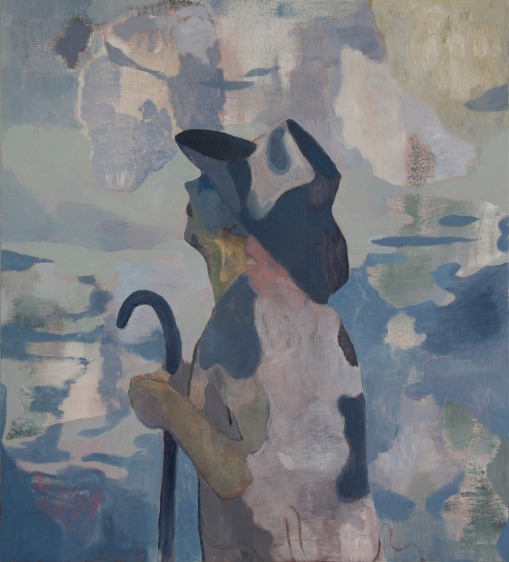In an instant all will vanish and we’ll be alone once more, in the midst of nothingness.
S. Beckett, Waiting for Godot. A tragicomedy in two acts, London, 1955.
The Irish artist Colm MacAthlaoich introduces by means of The Waiting Game a new artistic dimension where time and space are suspended. After Travelling Without Moving (2017) and Elsewhere To Be Found (2018), in whose titles were evident the antinomies and paradoxes related to temporality and spatiality, MacAthlaoich decides to continue and deepen these existential contradictions that often distinguish our contemporary existence.

The Waiting Game, explicit reference to the Samuel Beckett’s play Waiting for Godot, who as MacAthlaoich hailed from Dublin too, is part of the discussion on the instability of the human condition typical of the existentialism developed in the 20th century. Beckett gained from this for his Theater of the Absurd that thought on the individuality, the loneliness of self in front of the world, the uselessness, the precariousness, the absurdity of existence. In the same way, although not in a nihilistic key, MacAthlaoich addresses the existentialism question from a pictorial-artistic and relational level, thus overcoming the linguistic ties that had bothered Beckett during the translation of Waiting for Godot from French to English. The artist, freed from the constraints of the traditional written languages, is available to investigate his Being condition in relation to his painter role. Through the fluidity of his pictorial gestures and chromatisms that take on a universal metalanguage character, similar for plurality of understanding to the emotional one stimulated in this case by the visual perception of the paintings, MacAthlaoich faces the question of why he is painting and what are the motivations that push him to pictorial action, finding himself thus discussing the existentialism and the sense of instability of Being.
For MacAthlaoich painting is like observing the world by analysing it and breaking it down constantly through the colors of its palette that take on a lexical value. In his paintings the colors spread smoothly and in transparency by overlapping, they are in fact an essential component of his artistic language with which to express and describe the world. The artist, with a systematic methodology that begins precisely with Traveling Without Moving, confronts two deeply different cultural and social realities such as Ireland and Cyprus. The different intensity of light of two islands, so distant geographically, represents for a painter a decisive factor in his pictorial execution. Thus the MacAthlaoich’s oeuvre, affected by such environmental differences, has given rise to an intense comparison between subjects and abstract elements created by color contrasts.
The artist, as “being in the world”, found himself thought and confronted himself with new figurative and ideological themes that led him to a new examination in Elsewhere To Be Found. The rarefied representation of the previous cycle of works becomes more concrete, more figurative. MacAthlaoich, who moved to Madrid in Spain, now looks with a detached and more objective eye at the “sensorial reality” that surrounds him. Through an ontological research, he traces the Mythologies of the everyday life to describe it in his paintings. Inspired methodologically by the French semiologist Roland Barthes, who in 1957 treated the mythological theme in Western mass culture between 1954 and 1956, the artist treats certain Spanish myths as the figure of the bullfighter through his painting. This figure assumed a symbolic meaning in the collective imagination of bravery and courage or futile ferocity and cruelty towards the animal. In any case, this mythological role has often inspired Spanish artists, like the master Francisco Goya, who dedicated to Tauromaquia (1815-1816) a series of thirty-three engravings.
Bullfighting has often been interpreted as an allegorical synonym of the human story. It has Mithraic ancestry, where man symbolises the supremacy of moral forces over passions, the bull. Hence, the mystification of these two figures that become the protagonists of a collective representation capable of generating an ideological artifice. What the artist does instead is to overcome this abuse of signs and symbols and to describe, through his pictorial metalanguage, an equally mythological metalanguage like this of the bullfighter or other allegorical figures.
Ex-sistere, from the Latin “being out of”, in other words the search to come out of ourselves and look at the being as something else, which does not belong to us, coincides with the artistic vision of MacAthlaoich in The Waiting Game. He becomes an exegete of the world-environment who definitively frees any signifier from a tree, a man with a horse or a pilgrim, raising it to a new system of pictorial signs belonging to the consolidated lexis of the artist who contextualises them onto the emotional level.
The Heideggerian hic et nunc, id est our existence in space and time, places and defines the artist in a context of “effectiveness” of his presence in the world that invites him to his own understanding and to the world that surrounds him through the emotional situation. Every situation always arises in a time and in a defined space. Passing through the emotional sphere and, through Colm MacAthlaoich’s artistic interpretation, the spatiality and temporality of existence acquire a changeable meaning that follows the precariousness of existence through the figurative dissolution and the liquefaction of colors that, like a kaleidoscope, form on the canvas distorted images of reality. The banality of reality becomes an inner re-elaboration of the same reality that allows the artist to access a visual and emotional power capable of involving the observer in an impressive cognitive and emotional process. The sphere of the unconscious is urged to such an extent that suspends all temporal cognition since the image is ephemeral, so ethereal as to be difficult to grasp visually in its entirety.



